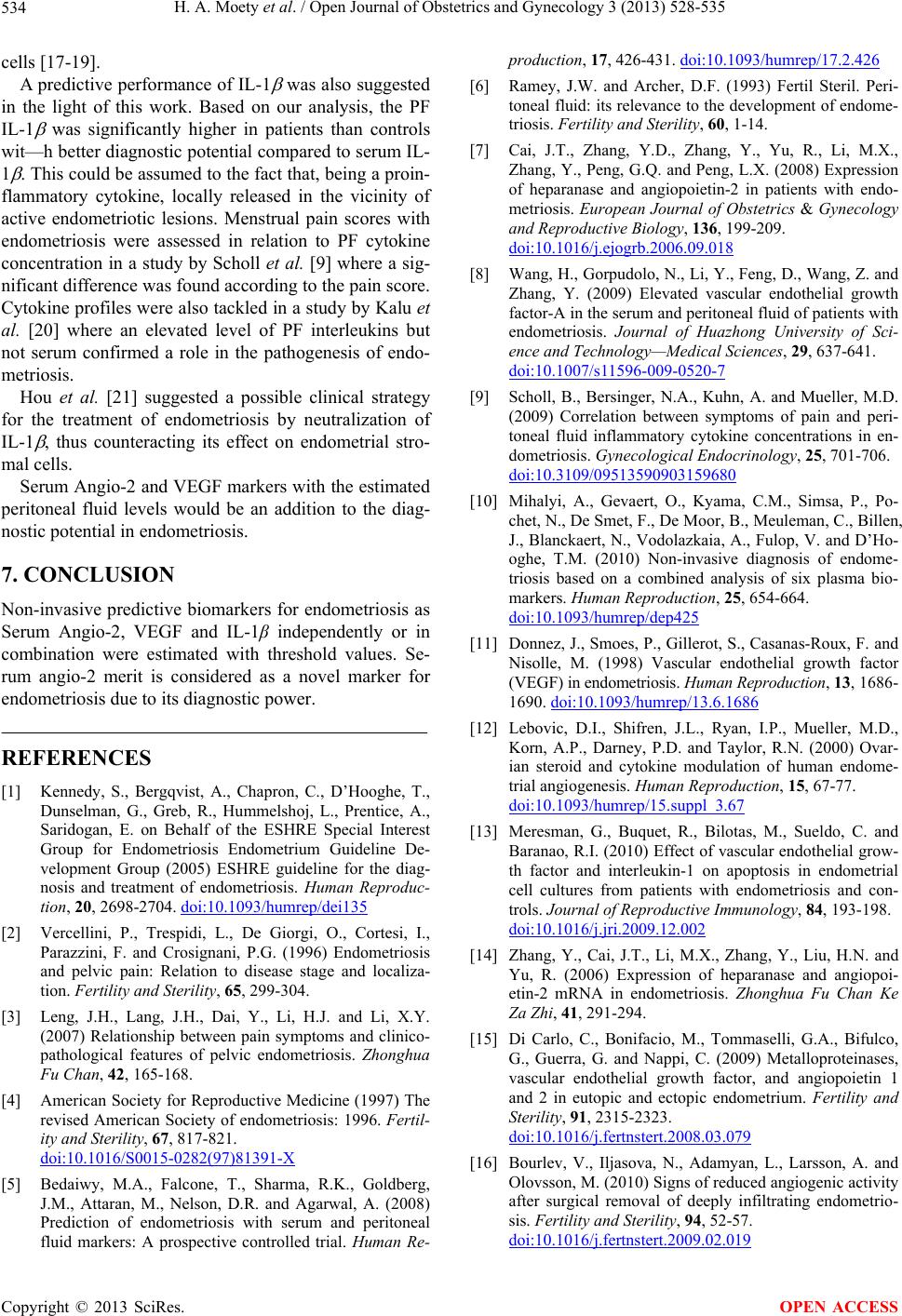
H. A. Moety et al. / Open Journal of Obstetrics and Gynecology 3 (2013) 528-535
534
cells [17-19].
A predictive performance of IL-1
was also suggested
in the light of this work. Based on our analysis, the PF
IL-1
was significantly higher in patients than controls
wit—h better diagnostic potential compared to serum IL-
1
. This could be assumed to the fact that, being a proin-
flammatory cytokine, locally released in the vicinity of
active endometriotic lesions. Menstrual pain scores with
endometriosis were assessed in relation to PF cytokine
concentration in a study by Scholl et al. [9] where a sig-
nificant difference was found according to the pain score.
Cytokine profiles were also tackled in a study by Kalu et
al. [20] where an elevated level of PF interleukins but
not serum confirmed a role in the pathogenesis of endo-
metriosis.
Hou et al. [21] suggested a possible clinical strategy
for the treatment of endometriosis by neutralization of
IL-1
, thus counteracting its effect on endometrial stro-
mal cells.
Serum Angio-2 and VEGF markers with the estimated
peritoneal fluid levels would be an addition to the diag-
nostic potential in endometriosis.
7. CONCLUSION
Non-invasive predictive biomarkers for endometriosis as
Serum Angio-2, VEGF and IL-1β independently or in
combination were estimated with threshold values. Se-
rum angio-2 merit is considered as a novel marker for
endometriosis due to its diagnostic power.
REFERENCES
[1] Kennedy, S., Bergqvist, A., Chapron, C., D’Hooghe, T.,
Dunselman, G., Greb, R., Hummelshoj, L., Prentice, A.,
Saridogan, E. on Behalf of the ESHRE Special Interest
Group for Endometriosis Endometrium Guideline De-
velopment Group (2005) ESHRE guideline for the diag-
nosis and treatment of endometriosis. Human Reproduc-
tion, 20, 2698-2704. doi:10.1093/humrep/dei135
[2] Vercellini, P., Trespidi, L., De Giorgi, O., Cortesi, I.,
Parazzini, F. and Crosignani, P.G. (1996) Endometriosis
and pelvic pain: Relation to disease stage and localiza-
tion. Fertility and Sterility, 65, 299-304.
[3] Leng, J.H., Lang, J.H., Dai, Y., Li, H.J. and Li, X.Y.
(2007) Relationship between pain symptoms and clinico-
pathological features of pelvic endometriosis. Zhonghua
Fu Chan, 42, 165-168.
[4] American Society for Reproductive Medicine (1997) The
revised American Society of endometriosis: 1996. Fertil-
ity and Sterility, 67, 817-821.
doi:10.1016/S0015-0282(97)81391-X
[5] Bedaiwy, M.A., Falcone, T., Sharma, R.K., Goldberg,
J.M., Attaran, M., Nelson, D.R. and Agarwal, A. (2008)
Prediction of endometriosis with serum and peritoneal
fluid markers: A prospective controlled trial. Human Re-
production, 17, 426-431. doi:10.1093/humrep/17.2.426
[6] Ramey, J.W. and Archer, D.F. (1993) Fertil Steril. Peri-
toneal fluid: its relevance to the development of endome-
triosis. Fertility and Sterility, 60, 1-14.
[7] Cai, J.T., Zhang, Y.D., Zhang, Y., Yu, R., Li, M.X.,
Zhang, Y., Peng, G.Q. and Peng, L.X. (2008) Expression
of heparanase and angiopoietin-2 in patients with endo-
metriosis. European Journal of Obstetrics & Gynecology
and Reproductive Biology, 136, 199-209.
doi:10.1016/j.ejogrb.2006.09.018
[8] Wang, H., Gorpudolo, N., Li, Y., Feng, D., Wang, Z. and
Zhang, Y. (2009) Elevated vascular endothelial growth
factor-A in the serum and peritoneal fluid of patients with
endometriosis. Journal of Huazhong University of Sci-
ence and Technology—Medical Sciences, 29, 637-641.
doi:10.1007/s11596-009-0520-7
[9] Scholl, B., Bersinger, N.A., Kuhn, A. and Mueller, M.D.
(2009) Correlation between symptoms of pain and peri-
toneal fluid inflammatory cytokine concentrations in en-
dometriosis. Gynecological Endocrinology, 25, 701-706.
doi:10.3109/09513590903159680
[10] Mihalyi, A., Gevaert, O., Kyama, C.M., Simsa, P., Po-
chet, N., De Smet, F., De Moor, B., Meuleman, C., Billen,
J., Blanckaert, N., Vodolazkaia, A., Fulop, V. and D’Ho-
oghe, T.M. (2010) Non-invasive diagnosis of endome-
triosis based on a combined analysis of six plasma bio-
markers. Human Reproduction, 25, 654-664.
doi:10.1093/humrep/dep425
[11] Donnez, J., Smoes, P., Gillerot, S., Casanas-Roux, F. and
Nisolle, M. (1998) Vascular endothelial growth factor
(VEGF) in endometriosis. Human Reproduction, 13, 1686-
1690. doi:10.1093/humrep/13.6.1686
[12] Lebovic, D.I., Shifren, J.L., Ryan, I.P., Mueller, M.D.,
Korn, A.P., Darney, P.D. and Taylor, R.N. (2000) Ovar-
ian steroid and cytokine modulation of human endome-
trial angiogenesis. Human Reproduction, 15, 67-77.
doi:10.1093/humrep/15.suppl_3.67
[13] Meresman, G., Buquet, R., Bilotas, M., Sueldo, C. and
Baranao, R.I. (2010) Effect of vascular endothelial grow-
th factor and interleukin-1 on apoptosis in endometrial
cell cultures from patients with endometriosis and con-
trols. Journal of Reproductive Immunology, 84, 193-198.
doi:10.1016/j.jri.2009.12.002
[14] Zhang, Y., Cai, J.T., Li, M.X., Zhang, Y., Liu, H.N. and
Yu, R. (2006) Expression of heparanase and angiopoi-
etin-2 mRNA in endometriosis. Zhonghua Fu Chan Ke
Za Zhi, 41, 291-294.
[15] Di Carlo, C., Bonifacio, M., Tommaselli, G.A., Bifulco,
G., Guerra, G. and Nappi, C. (2009) Metalloproteinases,
vascular endothelial growth factor, and angiopoietin 1
and 2 in eutopic and ectopic endometrium. Fertility and
Sterility, 91, 2315-2323.
doi:10.1016/j.fertnstert.2008.03.079
[16] Bourlev, V., Iljasova, N., Adamyan, L., Larsson, A. and
Olovsson, M. (2010) Signs of reduced angiogenic activity
after surgical removal of deeply infiltrating endometrio-
sis. Fertility and Sterility, 94, 52-57.
doi:10.1016/j.fertnstert.2009.02.019
Copyright © 2013 SciRes. OPEN ACCESS